Innovation and Commercialisation
VerifiedAdded on 2023/01/19
|15
|4924
|83
AI Summary
This report discusses the importance of innovation and commercialisation in business. It explores the role of vision and teamwork in shaping innovation and highlights the 4 P's of innovation. The concept of frugal innovation is also discussed. Additionally, the report emphasizes the significance of the commercial funnel and NPD application in driving business growth.
Contribute Materials
Your contribution can guide someone’s learning journey. Share your
documents today.
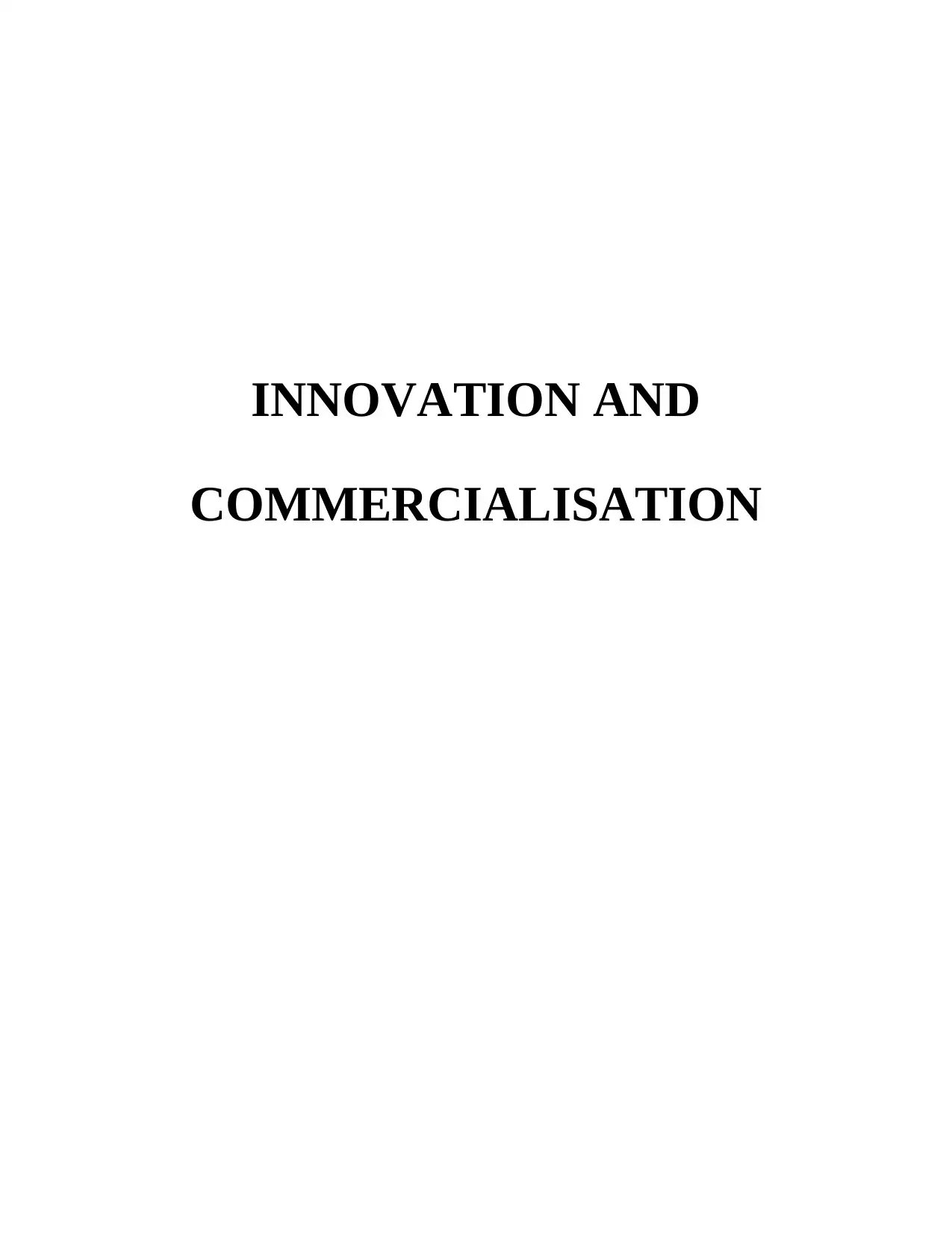
INNOVATION AND
COMMERCIALISATION
COMMERCIALISATION
Secure Best Marks with AI Grader
Need help grading? Try our AI Grader for instant feedback on your assignments.
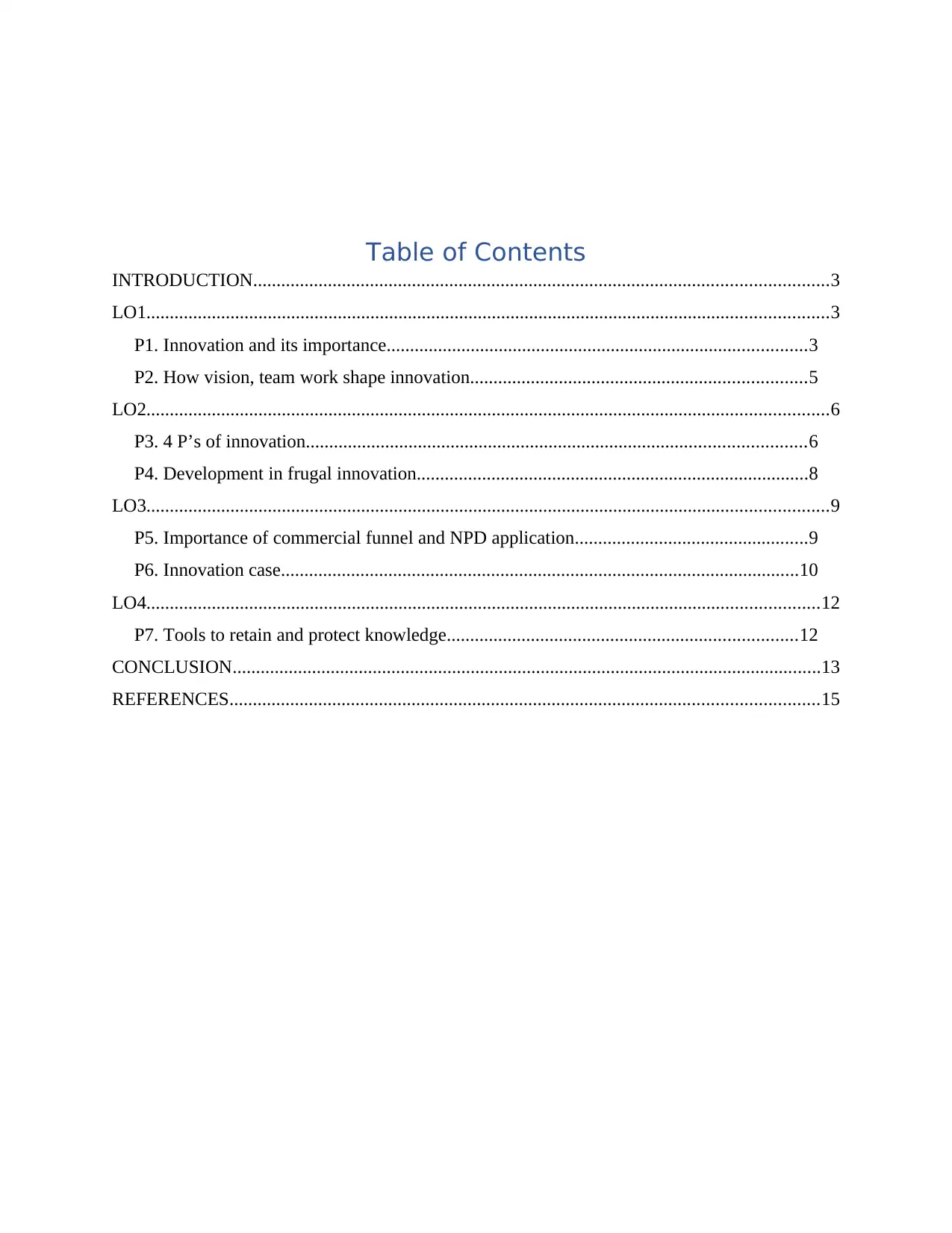
Table of Contents
INTRODUCTION...........................................................................................................................3
LO1..................................................................................................................................................3
P1. Innovation and its importance..........................................................................................3
P2. How vision, team work shape innovation........................................................................5
LO2..................................................................................................................................................6
P3. 4 P’s of innovation...........................................................................................................6
P4. Development in frugal innovation....................................................................................8
LO3..................................................................................................................................................9
P5. Importance of commercial funnel and NPD application..................................................9
P6. Innovation case...............................................................................................................10
LO4................................................................................................................................................12
P7. Tools to retain and protect knowledge...........................................................................12
CONCLUSION..............................................................................................................................13
REFERENCES..............................................................................................................................15
INTRODUCTION...........................................................................................................................3
LO1..................................................................................................................................................3
P1. Innovation and its importance..........................................................................................3
P2. How vision, team work shape innovation........................................................................5
LO2..................................................................................................................................................6
P3. 4 P’s of innovation...........................................................................................................6
P4. Development in frugal innovation....................................................................................8
LO3..................................................................................................................................................9
P5. Importance of commercial funnel and NPD application..................................................9
P6. Innovation case...............................................................................................................10
LO4................................................................................................................................................12
P7. Tools to retain and protect knowledge...........................................................................12
CONCLUSION..............................................................................................................................13
REFERENCES..............................................................................................................................15
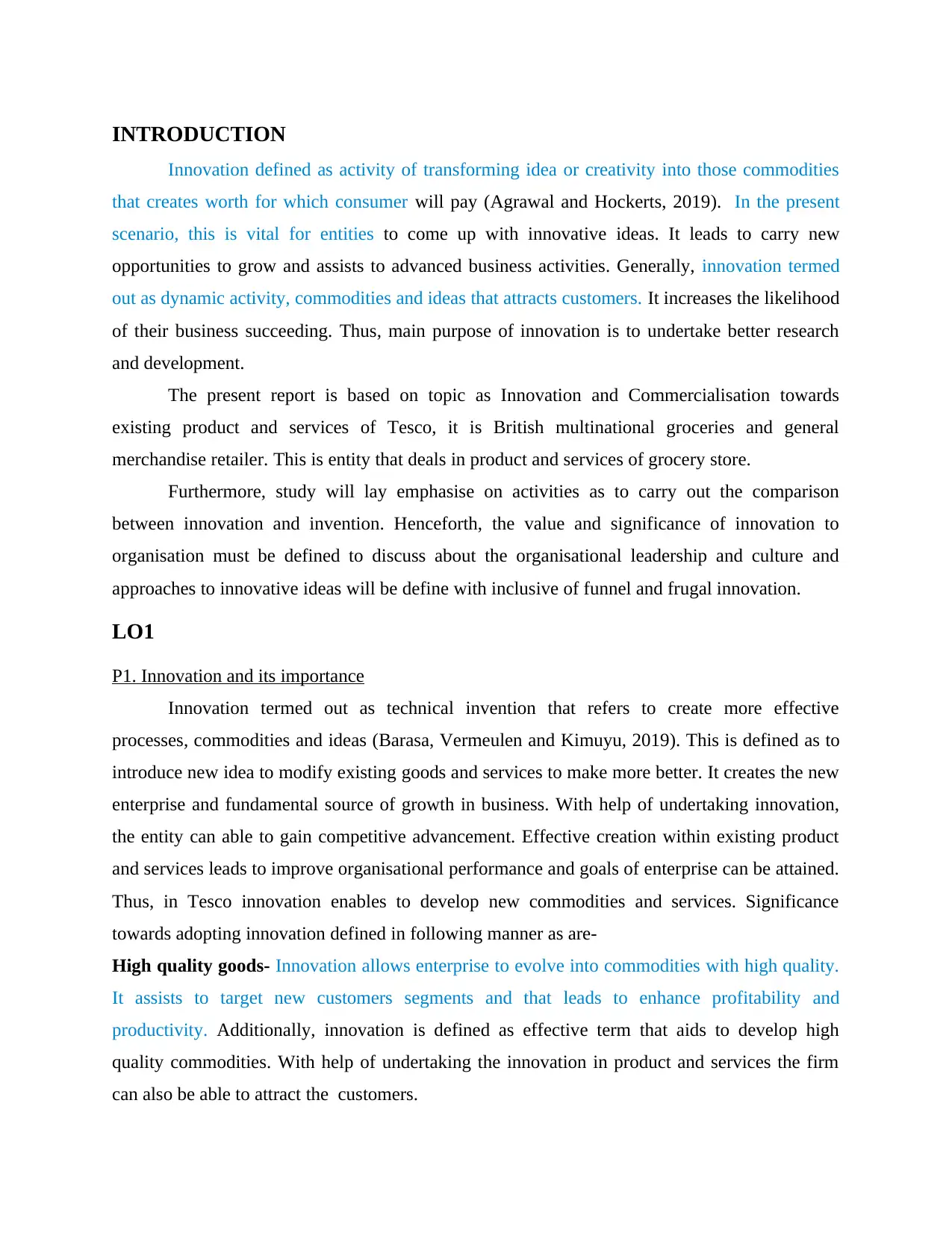
INTRODUCTION
Innovation defined as activity of transforming idea or creativity into those commodities
that creates worth for which consumer will pay (Agrawal and Hockerts, 2019). In the present
scenario, this is vital for entities to come up with innovative ideas. It leads to carry new
opportunities to grow and assists to advanced business activities. Generally, innovation termed
out as dynamic activity, commodities and ideas that attracts customers. It increases the likelihood
of their business succeeding. Thus, main purpose of innovation is to undertake better research
and development.
The present report is based on topic as Innovation and Commercialisation towards
existing product and services of Tesco, it is British multinational groceries and general
merchandise retailer. This is entity that deals in product and services of grocery store.
Furthermore, study will lay emphasise on activities as to carry out the comparison
between innovation and invention. Henceforth, the value and significance of innovation to
organisation must be defined to discuss about the organisational leadership and culture and
approaches to innovative ideas will be define with inclusive of funnel and frugal innovation.
LO1
P1. Innovation and its importance
Innovation termed out as technical invention that refers to create more effective
processes, commodities and ideas (Barasa, Vermeulen and Kimuyu, 2019). This is defined as to
introduce new idea to modify existing goods and services to make more better. It creates the new
enterprise and fundamental source of growth in business. With help of undertaking innovation,
the entity can able to gain competitive advancement. Effective creation within existing product
and services leads to improve organisational performance and goals of enterprise can be attained.
Thus, in Tesco innovation enables to develop new commodities and services. Significance
towards adopting innovation defined in following manner as are-
High quality goods- Innovation allows enterprise to evolve into commodities with high quality.
It assists to target new customers segments and that leads to enhance profitability and
productivity. Additionally, innovation is defined as effective term that aids to develop high
quality commodities. With help of undertaking the innovation in product and services the firm
can also be able to attract the customers.
Innovation defined as activity of transforming idea or creativity into those commodities
that creates worth for which consumer will pay (Agrawal and Hockerts, 2019). In the present
scenario, this is vital for entities to come up with innovative ideas. It leads to carry new
opportunities to grow and assists to advanced business activities. Generally, innovation termed
out as dynamic activity, commodities and ideas that attracts customers. It increases the likelihood
of their business succeeding. Thus, main purpose of innovation is to undertake better research
and development.
The present report is based on topic as Innovation and Commercialisation towards
existing product and services of Tesco, it is British multinational groceries and general
merchandise retailer. This is entity that deals in product and services of grocery store.
Furthermore, study will lay emphasise on activities as to carry out the comparison
between innovation and invention. Henceforth, the value and significance of innovation to
organisation must be defined to discuss about the organisational leadership and culture and
approaches to innovative ideas will be define with inclusive of funnel and frugal innovation.
LO1
P1. Innovation and its importance
Innovation termed out as technical invention that refers to create more effective
processes, commodities and ideas (Barasa, Vermeulen and Kimuyu, 2019). This is defined as to
introduce new idea to modify existing goods and services to make more better. It creates the new
enterprise and fundamental source of growth in business. With help of undertaking innovation,
the entity can able to gain competitive advancement. Effective creation within existing product
and services leads to improve organisational performance and goals of enterprise can be attained.
Thus, in Tesco innovation enables to develop new commodities and services. Significance
towards adopting innovation defined in following manner as are-
High quality goods- Innovation allows enterprise to evolve into commodities with high quality.
It assists to target new customers segments and that leads to enhance profitability and
productivity. Additionally, innovation is defined as effective term that aids to develop high
quality commodities. With help of undertaking the innovation in product and services the firm
can also be able to attract the customers.
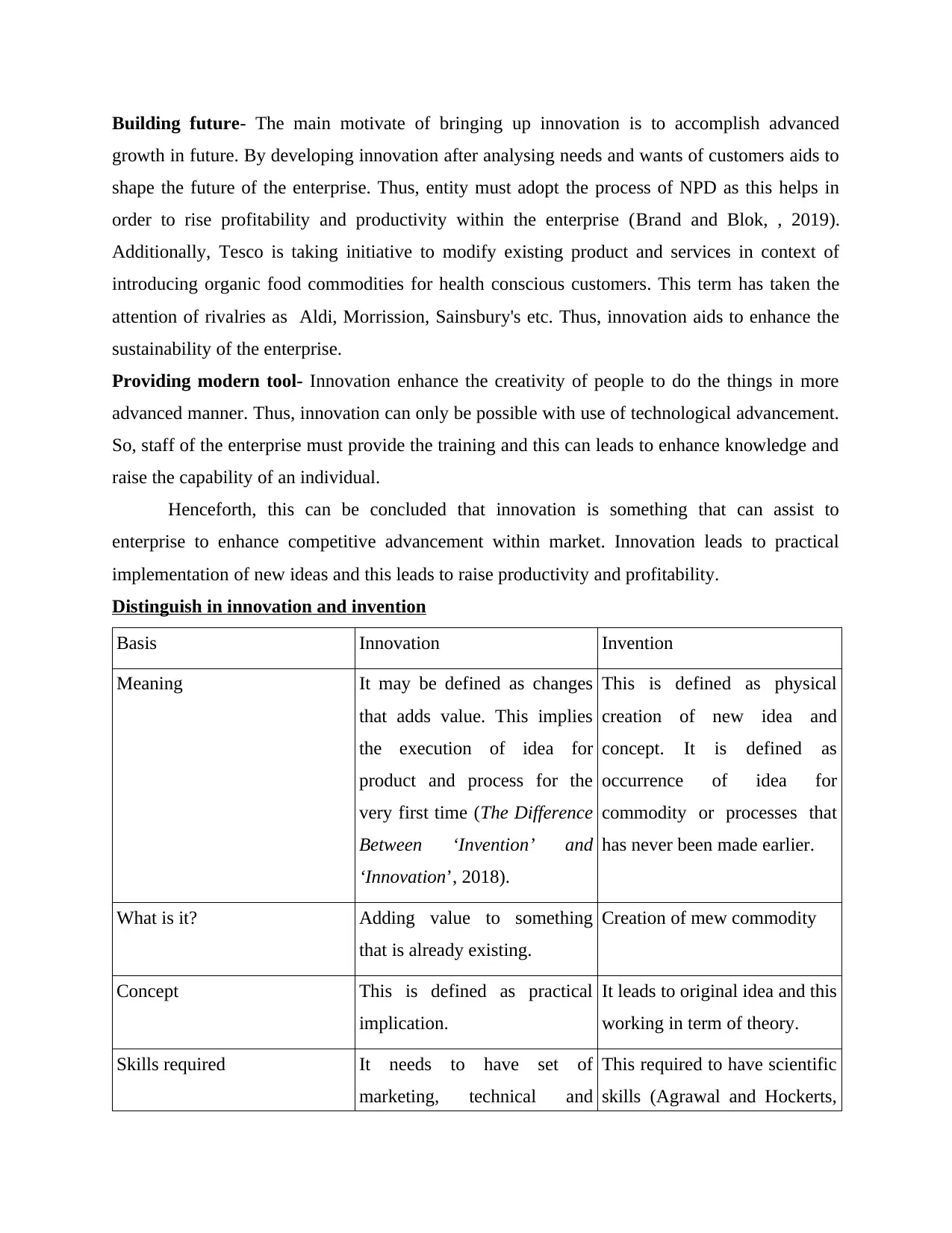
Building future- The main motivate of bringing up innovation is to accomplish advanced
growth in future. By developing innovation after analysing needs and wants of customers aids to
shape the future of the enterprise. Thus, entity must adopt the process of NPD as this helps in
order to rise profitability and productivity within the enterprise (Brand and Blok, , 2019).
Additionally, Tesco is taking initiative to modify existing product and services in context of
introducing organic food commodities for health conscious customers. This term has taken the
attention of rivalries as Aldi, Morrission, Sainsbury's etc. Thus, innovation aids to enhance the
sustainability of the enterprise.
Providing modern tool- Innovation enhance the creativity of people to do the things in more
advanced manner. Thus, innovation can only be possible with use of technological advancement.
So, staff of the enterprise must provide the training and this can leads to enhance knowledge and
raise the capability of an individual.
Henceforth, this can be concluded that innovation is something that can assist to
enterprise to enhance competitive advancement within market. Innovation leads to practical
implementation of new ideas and this leads to raise productivity and profitability.
Distinguish in innovation and invention
Basis Innovation Invention
Meaning It may be defined as changes
that adds value. This implies
the execution of idea for
product and process for the
very first time (The Difference
Between ‘Invention’ and
‘Innovation’, 2018).
This is defined as physical
creation of new idea and
concept. It is defined as
occurrence of idea for
commodity or processes that
has never been made earlier.
What is it? Adding value to something
that is already existing.
Creation of mew commodity
Concept This is defined as practical
implication.
It leads to original idea and this
working in term of theory.
Skills required It needs to have set of
marketing, technical and
This required to have scientific
skills (Agrawal and Hockerts,
growth in future. By developing innovation after analysing needs and wants of customers aids to
shape the future of the enterprise. Thus, entity must adopt the process of NPD as this helps in
order to rise profitability and productivity within the enterprise (Brand and Blok, , 2019).
Additionally, Tesco is taking initiative to modify existing product and services in context of
introducing organic food commodities for health conscious customers. This term has taken the
attention of rivalries as Aldi, Morrission, Sainsbury's etc. Thus, innovation aids to enhance the
sustainability of the enterprise.
Providing modern tool- Innovation enhance the creativity of people to do the things in more
advanced manner. Thus, innovation can only be possible with use of technological advancement.
So, staff of the enterprise must provide the training and this can leads to enhance knowledge and
raise the capability of an individual.
Henceforth, this can be concluded that innovation is something that can assist to
enterprise to enhance competitive advancement within market. Innovation leads to practical
implementation of new ideas and this leads to raise productivity and profitability.
Distinguish in innovation and invention
Basis Innovation Invention
Meaning It may be defined as changes
that adds value. This implies
the execution of idea for
product and process for the
very first time (The Difference
Between ‘Invention’ and
‘Innovation’, 2018).
This is defined as physical
creation of new idea and
concept. It is defined as
occurrence of idea for
commodity or processes that
has never been made earlier.
What is it? Adding value to something
that is already existing.
Creation of mew commodity
Concept This is defined as practical
implication.
It leads to original idea and this
working in term of theory.
Skills required It needs to have set of
marketing, technical and
This required to have scientific
skills (Agrawal and Hockerts,
Secure Best Marks with AI Grader
Need help grading? Try our AI Grader for instant feedback on your assignments.
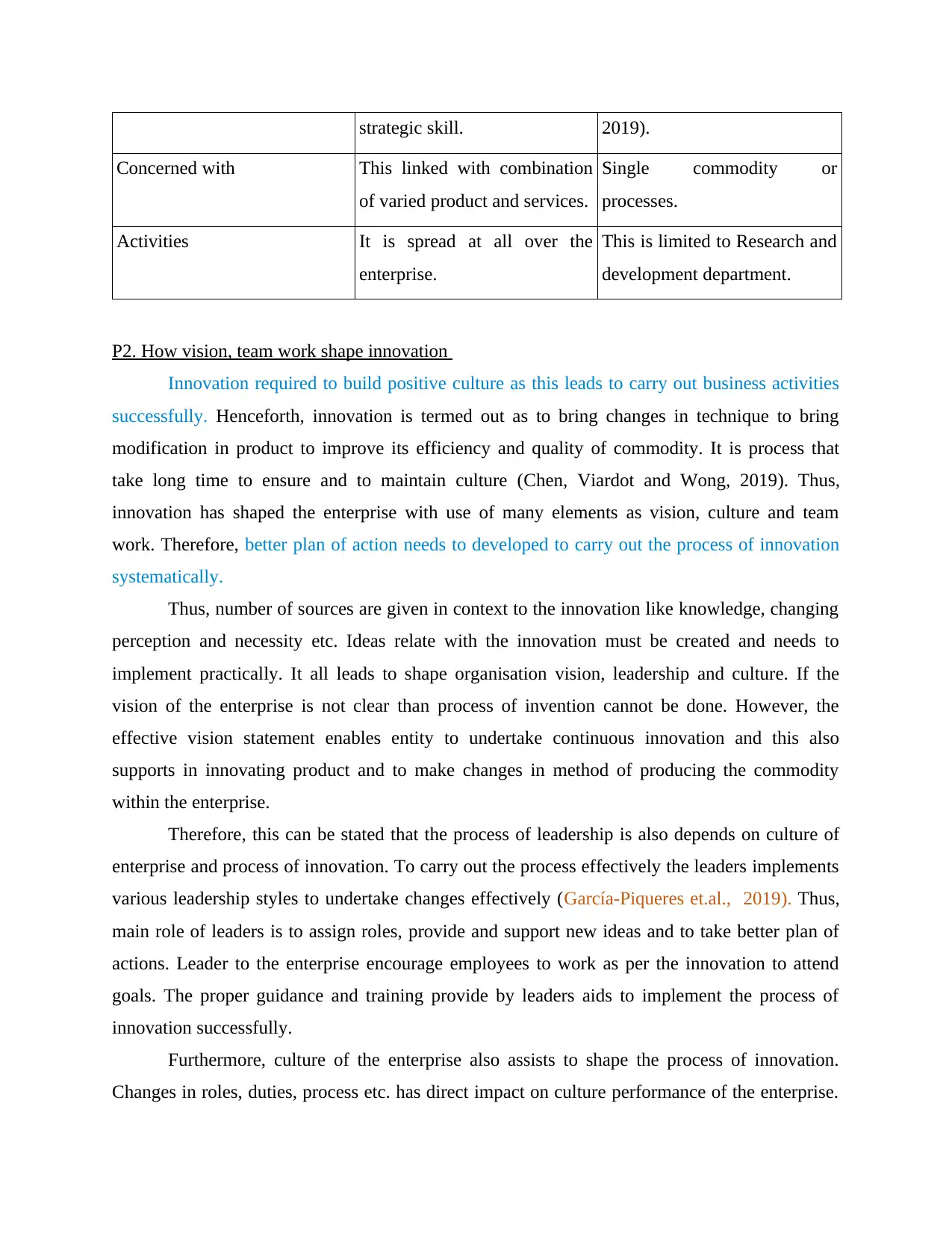
strategic skill. 2019).
Concerned with This linked with combination
of varied product and services.
Single commodity or
processes.
Activities It is spread at all over the
enterprise.
This is limited to Research and
development department.
P2. How vision, team work shape innovation
Innovation required to build positive culture as this leads to carry out business activities
successfully. Henceforth, innovation is termed out as to bring changes in technique to bring
modification in product to improve its efficiency and quality of commodity. It is process that
take long time to ensure and to maintain culture (Chen, Viardot and Wong, 2019). Thus,
innovation has shaped the enterprise with use of many elements as vision, culture and team
work. Therefore, better plan of action needs to developed to carry out the process of innovation
systematically.
Thus, number of sources are given in context to the innovation like knowledge, changing
perception and necessity etc. Ideas relate with the innovation must be created and needs to
implement practically. It all leads to shape organisation vision, leadership and culture. If the
vision of the enterprise is not clear than process of invention cannot be done. However, the
effective vision statement enables entity to undertake continuous innovation and this also
supports in innovating product and to make changes in method of producing the commodity
within the enterprise.
Therefore, this can be stated that the process of leadership is also depends on culture of
enterprise and process of innovation. To carry out the process effectively the leaders implements
various leadership styles to undertake changes effectively (García-Piqueres et.al., 2019). Thus,
main role of leaders is to assign roles, provide and support new ideas and to take better plan of
actions. Leader to the enterprise encourage employees to work as per the innovation to attend
goals. The proper guidance and training provide by leaders aids to implement the process of
innovation successfully.
Furthermore, culture of the enterprise also assists to shape the process of innovation.
Changes in roles, duties, process etc. has direct impact on culture performance of the enterprise.
Concerned with This linked with combination
of varied product and services.
Single commodity or
processes.
Activities It is spread at all over the
enterprise.
This is limited to Research and
development department.
P2. How vision, team work shape innovation
Innovation required to build positive culture as this leads to carry out business activities
successfully. Henceforth, innovation is termed out as to bring changes in technique to bring
modification in product to improve its efficiency and quality of commodity. It is process that
take long time to ensure and to maintain culture (Chen, Viardot and Wong, 2019). Thus,
innovation has shaped the enterprise with use of many elements as vision, culture and team
work. Therefore, better plan of action needs to developed to carry out the process of innovation
systematically.
Thus, number of sources are given in context to the innovation like knowledge, changing
perception and necessity etc. Ideas relate with the innovation must be created and needs to
implement practically. It all leads to shape organisation vision, leadership and culture. If the
vision of the enterprise is not clear than process of invention cannot be done. However, the
effective vision statement enables entity to undertake continuous innovation and this also
supports in innovating product and to make changes in method of producing the commodity
within the enterprise.
Therefore, this can be stated that the process of leadership is also depends on culture of
enterprise and process of innovation. To carry out the process effectively the leaders implements
various leadership styles to undertake changes effectively (García-Piqueres et.al., 2019). Thus,
main role of leaders is to assign roles, provide and support new ideas and to take better plan of
actions. Leader to the enterprise encourage employees to work as per the innovation to attend
goals. The proper guidance and training provide by leaders aids to implement the process of
innovation successfully.
Furthermore, culture of the enterprise also assists to shape the process of innovation.
Changes in roles, duties, process etc. has direct impact on culture performance of the enterprise.
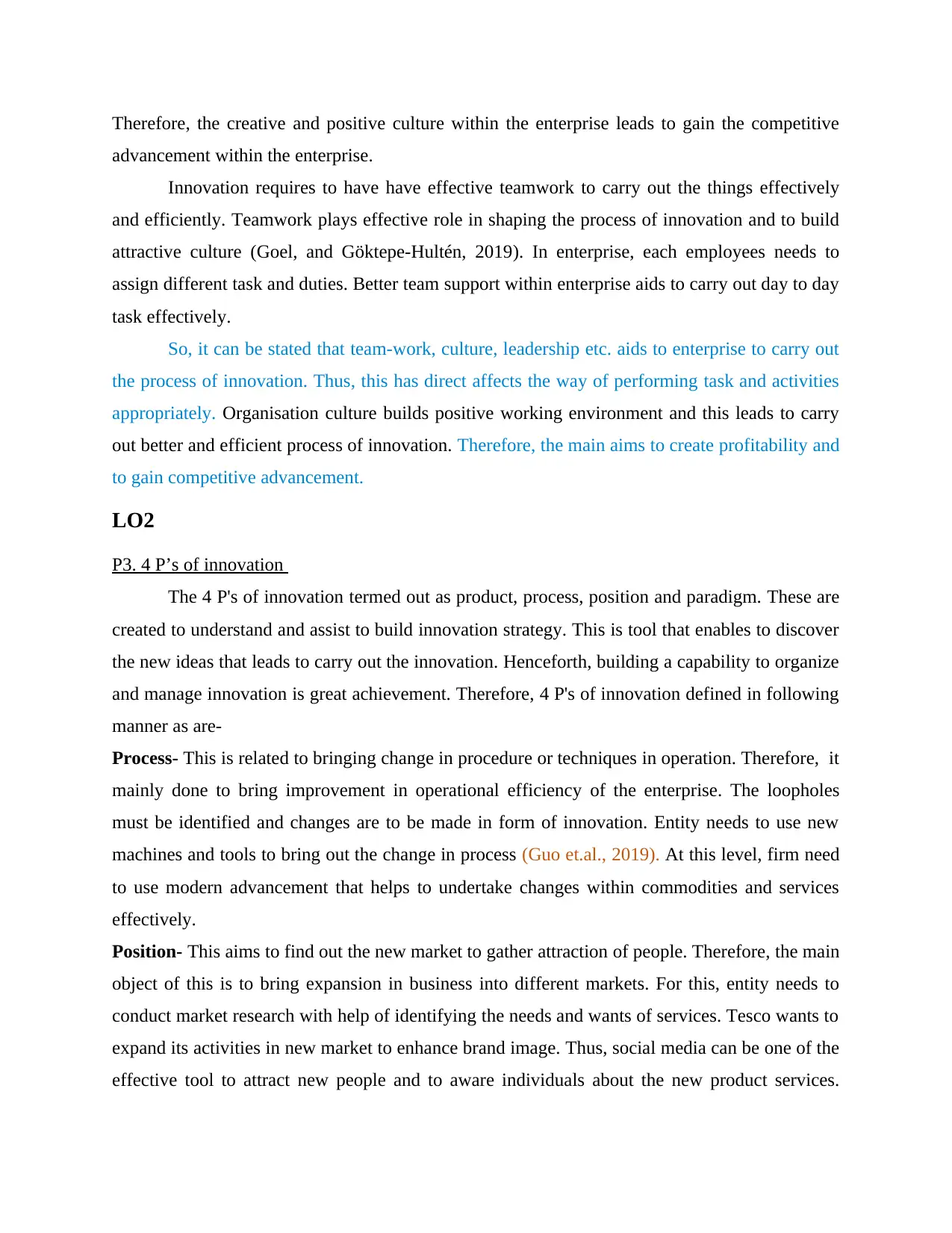
Therefore, the creative and positive culture within the enterprise leads to gain the competitive
advancement within the enterprise.
Innovation requires to have have effective teamwork to carry out the things effectively
and efficiently. Teamwork plays effective role in shaping the process of innovation and to build
attractive culture (Goel, and Göktepe-Hultén, 2019). In enterprise, each employees needs to
assign different task and duties. Better team support within enterprise aids to carry out day to day
task effectively.
So, it can be stated that team-work, culture, leadership etc. aids to enterprise to carry out
the process of innovation. Thus, this has direct affects the way of performing task and activities
appropriately. Organisation culture builds positive working environment and this leads to carry
out better and efficient process of innovation. Therefore, the main aims to create profitability and
to gain competitive advancement.
LO2
P3. 4 P’s of innovation
The 4 P's of innovation termed out as product, process, position and paradigm. These are
created to understand and assist to build innovation strategy. This is tool that enables to discover
the new ideas that leads to carry out the innovation. Henceforth, building a capability to organize
and manage innovation is great achievement. Therefore, 4 P's of innovation defined in following
manner as are-
Process- This is related to bringing change in procedure or techniques in operation. Therefore, it
mainly done to bring improvement in operational efficiency of the enterprise. The loopholes
must be identified and changes are to be made in form of innovation. Entity needs to use new
machines and tools to bring out the change in process (Guo et.al., 2019). At this level, firm need
to use modern advancement that helps to undertake changes within commodities and services
effectively.
Position- This aims to find out the new market to gather attraction of people. Therefore, the main
object of this is to bring expansion in business into different markets. For this, entity needs to
conduct market research with help of identifying the needs and wants of services. Tesco wants to
expand its activities in new market to enhance brand image. Thus, social media can be one of the
effective tool to attract new people and to aware individuals about the new product services.
advancement within the enterprise.
Innovation requires to have have effective teamwork to carry out the things effectively
and efficiently. Teamwork plays effective role in shaping the process of innovation and to build
attractive culture (Goel, and Göktepe-Hultén, 2019). In enterprise, each employees needs to
assign different task and duties. Better team support within enterprise aids to carry out day to day
task effectively.
So, it can be stated that team-work, culture, leadership etc. aids to enterprise to carry out
the process of innovation. Thus, this has direct affects the way of performing task and activities
appropriately. Organisation culture builds positive working environment and this leads to carry
out better and efficient process of innovation. Therefore, the main aims to create profitability and
to gain competitive advancement.
LO2
P3. 4 P’s of innovation
The 4 P's of innovation termed out as product, process, position and paradigm. These are
created to understand and assist to build innovation strategy. This is tool that enables to discover
the new ideas that leads to carry out the innovation. Henceforth, building a capability to organize
and manage innovation is great achievement. Therefore, 4 P's of innovation defined in following
manner as are-
Process- This is related to bringing change in procedure or techniques in operation. Therefore, it
mainly done to bring improvement in operational efficiency of the enterprise. The loopholes
must be identified and changes are to be made in form of innovation. Entity needs to use new
machines and tools to bring out the change in process (Guo et.al., 2019). At this level, firm need
to use modern advancement that helps to undertake changes within commodities and services
effectively.
Position- This aims to find out the new market to gather attraction of people. Therefore, the main
object of this is to bring expansion in business into different markets. For this, entity needs to
conduct market research with help of identifying the needs and wants of services. Tesco wants to
expand its activities in new market to enhance brand image. Thus, social media can be one of the
effective tool to attract new people and to aware individuals about the new product services.
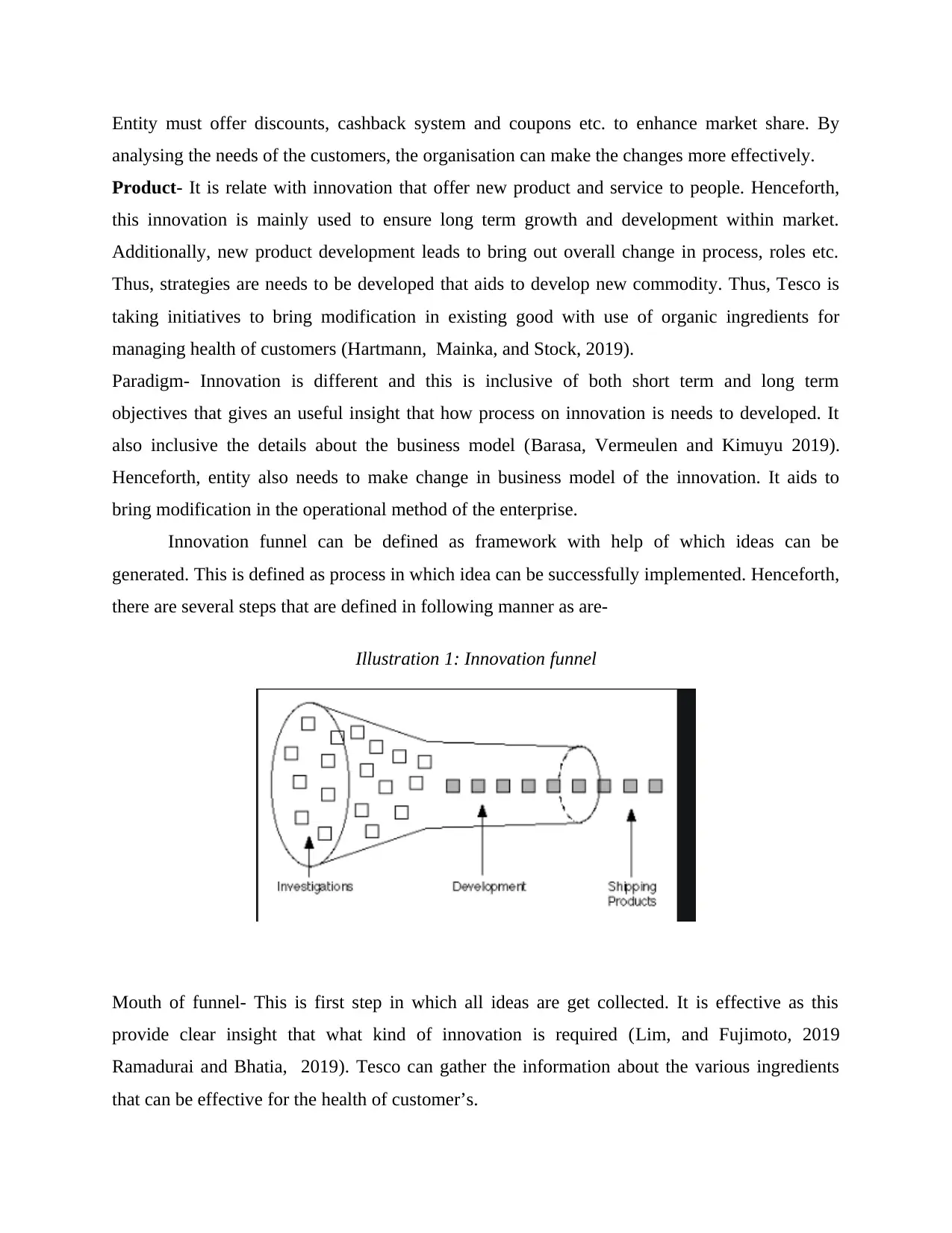
Entity must offer discounts, cashback system and coupons etc. to enhance market share. By
analysing the needs of the customers, the organisation can make the changes more effectively.
Product- It is relate with innovation that offer new product and service to people. Henceforth,
this innovation is mainly used to ensure long term growth and development within market.
Additionally, new product development leads to bring out overall change in process, roles etc.
Thus, strategies are needs to be developed that aids to develop new commodity. Thus, Tesco is
taking initiatives to bring modification in existing good with use of organic ingredients for
managing health of customers (Hartmann, Mainka, and Stock, 2019).
Paradigm- Innovation is different and this is inclusive of both short term and long term
objectives that gives an useful insight that how process on innovation is needs to developed. It
also inclusive the details about the business model (Barasa, Vermeulen and Kimuyu 2019).
Henceforth, entity also needs to make change in business model of the innovation. It aids to
bring modification in the operational method of the enterprise.
Innovation funnel can be defined as framework with help of which ideas can be
generated. This is defined as process in which idea can be successfully implemented. Henceforth,
there are several steps that are defined in following manner as are-
Mouth of funnel- This is first step in which all ideas are get collected. It is effective as this
provide clear insight that what kind of innovation is required (Lim, and Fujimoto, 2019
Ramadurai and Bhatia, 2019). Tesco can gather the information about the various ingredients
that can be effective for the health of customer’s.
Illustration 1: Innovation funnel
analysing the needs of the customers, the organisation can make the changes more effectively.
Product- It is relate with innovation that offer new product and service to people. Henceforth,
this innovation is mainly used to ensure long term growth and development within market.
Additionally, new product development leads to bring out overall change in process, roles etc.
Thus, strategies are needs to be developed that aids to develop new commodity. Thus, Tesco is
taking initiatives to bring modification in existing good with use of organic ingredients for
managing health of customers (Hartmann, Mainka, and Stock, 2019).
Paradigm- Innovation is different and this is inclusive of both short term and long term
objectives that gives an useful insight that how process on innovation is needs to developed. It
also inclusive the details about the business model (Barasa, Vermeulen and Kimuyu 2019).
Henceforth, entity also needs to make change in business model of the innovation. It aids to
bring modification in the operational method of the enterprise.
Innovation funnel can be defined as framework with help of which ideas can be
generated. This is defined as process in which idea can be successfully implemented. Henceforth,
there are several steps that are defined in following manner as are-
Mouth of funnel- This is first step in which all ideas are get collected. It is effective as this
provide clear insight that what kind of innovation is required (Lim, and Fujimoto, 2019
Ramadurai and Bhatia, 2019). Tesco can gather the information about the various ingredients
that can be effective for the health of customer’s.
Illustration 1: Innovation funnel
Paraphrase This Document
Need a fresh take? Get an instant paraphrase of this document with our AI Paraphraser
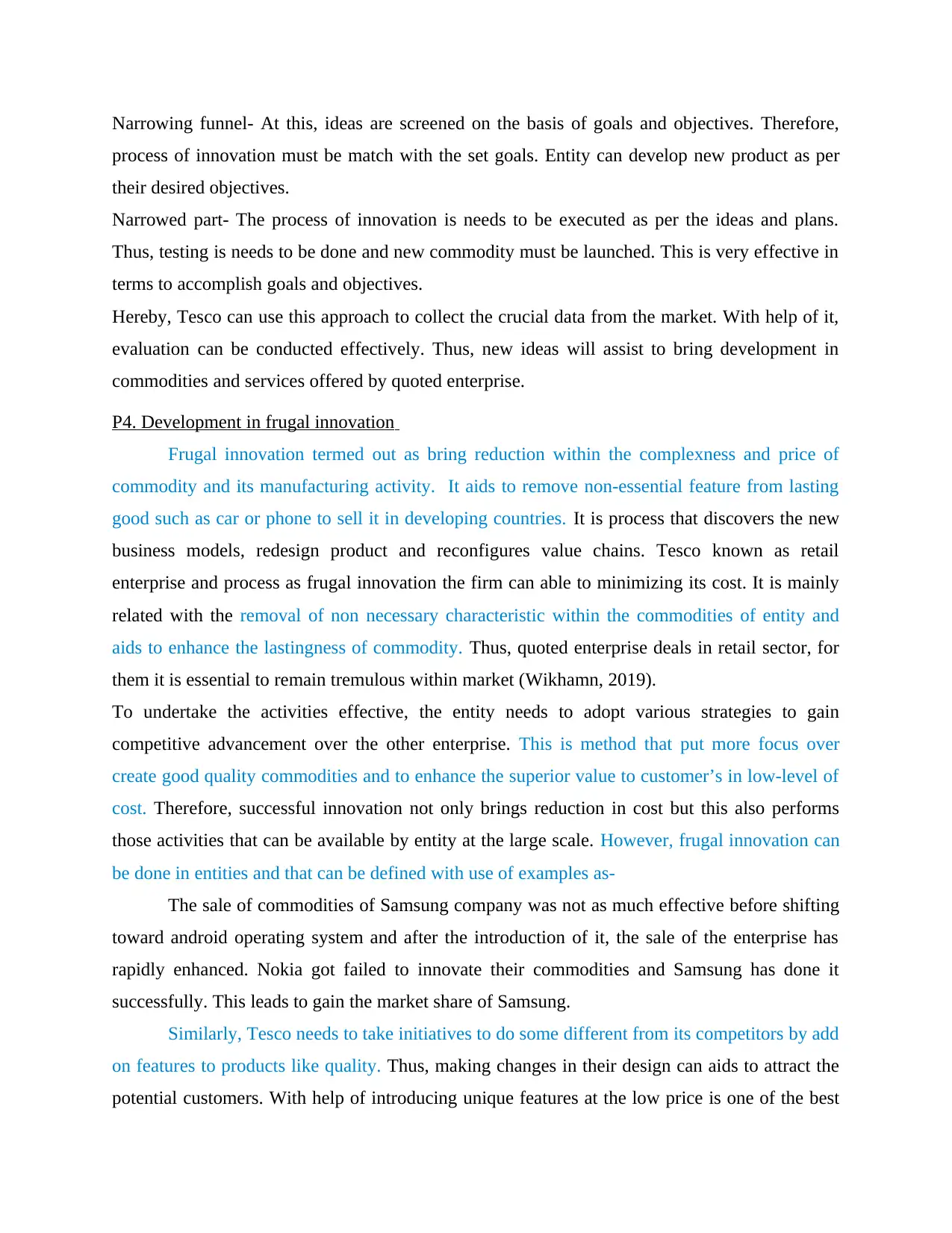
Narrowing funnel- At this, ideas are screened on the basis of goals and objectives. Therefore,
process of innovation must be match with the set goals. Entity can develop new product as per
their desired objectives.
Narrowed part- The process of innovation is needs to be executed as per the ideas and plans.
Thus, testing is needs to be done and new commodity must be launched. This is very effective in
terms to accomplish goals and objectives.
Hereby, Tesco can use this approach to collect the crucial data from the market. With help of it,
evaluation can be conducted effectively. Thus, new ideas will assist to bring development in
commodities and services offered by quoted enterprise.
P4. Development in frugal innovation
Frugal innovation termed out as bring reduction within the complexness and price of
commodity and its manufacturing activity. It aids to remove non-essential feature from lasting
good such as car or phone to sell it in developing countries. It is process that discovers the new
business models, redesign product and reconfigures value chains. Tesco known as retail
enterprise and process as frugal innovation the firm can able to minimizing its cost. It is mainly
related with the removal of non necessary characteristic within the commodities of entity and
aids to enhance the lastingness of commodity. Thus, quoted enterprise deals in retail sector, for
them it is essential to remain tremulous within market (Wikhamn, 2019).
To undertake the activities effective, the entity needs to adopt various strategies to gain
competitive advancement over the other enterprise. This is method that put more focus over
create good quality commodities and to enhance the superior value to customer’s in low-level of
cost. Therefore, successful innovation not only brings reduction in cost but this also performs
those activities that can be available by entity at the large scale. However, frugal innovation can
be done in entities and that can be defined with use of examples as-
The sale of commodities of Samsung company was not as much effective before shifting
toward android operating system and after the introduction of it, the sale of the enterprise has
rapidly enhanced. Nokia got failed to innovate their commodities and Samsung has done it
successfully. This leads to gain the market share of Samsung.
Similarly, Tesco needs to take initiatives to do some different from its competitors by add
on features to products like quality. Thus, making changes in their design can aids to attract the
potential customers. With help of introducing unique features at the low price is one of the best
process of innovation must be match with the set goals. Entity can develop new product as per
their desired objectives.
Narrowed part- The process of innovation is needs to be executed as per the ideas and plans.
Thus, testing is needs to be done and new commodity must be launched. This is very effective in
terms to accomplish goals and objectives.
Hereby, Tesco can use this approach to collect the crucial data from the market. With help of it,
evaluation can be conducted effectively. Thus, new ideas will assist to bring development in
commodities and services offered by quoted enterprise.
P4. Development in frugal innovation
Frugal innovation termed out as bring reduction within the complexness and price of
commodity and its manufacturing activity. It aids to remove non-essential feature from lasting
good such as car or phone to sell it in developing countries. It is process that discovers the new
business models, redesign product and reconfigures value chains. Tesco known as retail
enterprise and process as frugal innovation the firm can able to minimizing its cost. It is mainly
related with the removal of non necessary characteristic within the commodities of entity and
aids to enhance the lastingness of commodity. Thus, quoted enterprise deals in retail sector, for
them it is essential to remain tremulous within market (Wikhamn, 2019).
To undertake the activities effective, the entity needs to adopt various strategies to gain
competitive advancement over the other enterprise. This is method that put more focus over
create good quality commodities and to enhance the superior value to customer’s in low-level of
cost. Therefore, successful innovation not only brings reduction in cost but this also performs
those activities that can be available by entity at the large scale. However, frugal innovation can
be done in entities and that can be defined with use of examples as-
The sale of commodities of Samsung company was not as much effective before shifting
toward android operating system and after the introduction of it, the sale of the enterprise has
rapidly enhanced. Nokia got failed to innovate their commodities and Samsung has done it
successfully. This leads to gain the market share of Samsung.
Similarly, Tesco needs to take initiatives to do some different from its competitors by add
on features to products like quality. Thus, making changes in their design can aids to attract the
potential customers. With help of introducing unique features at the low price is one of the best
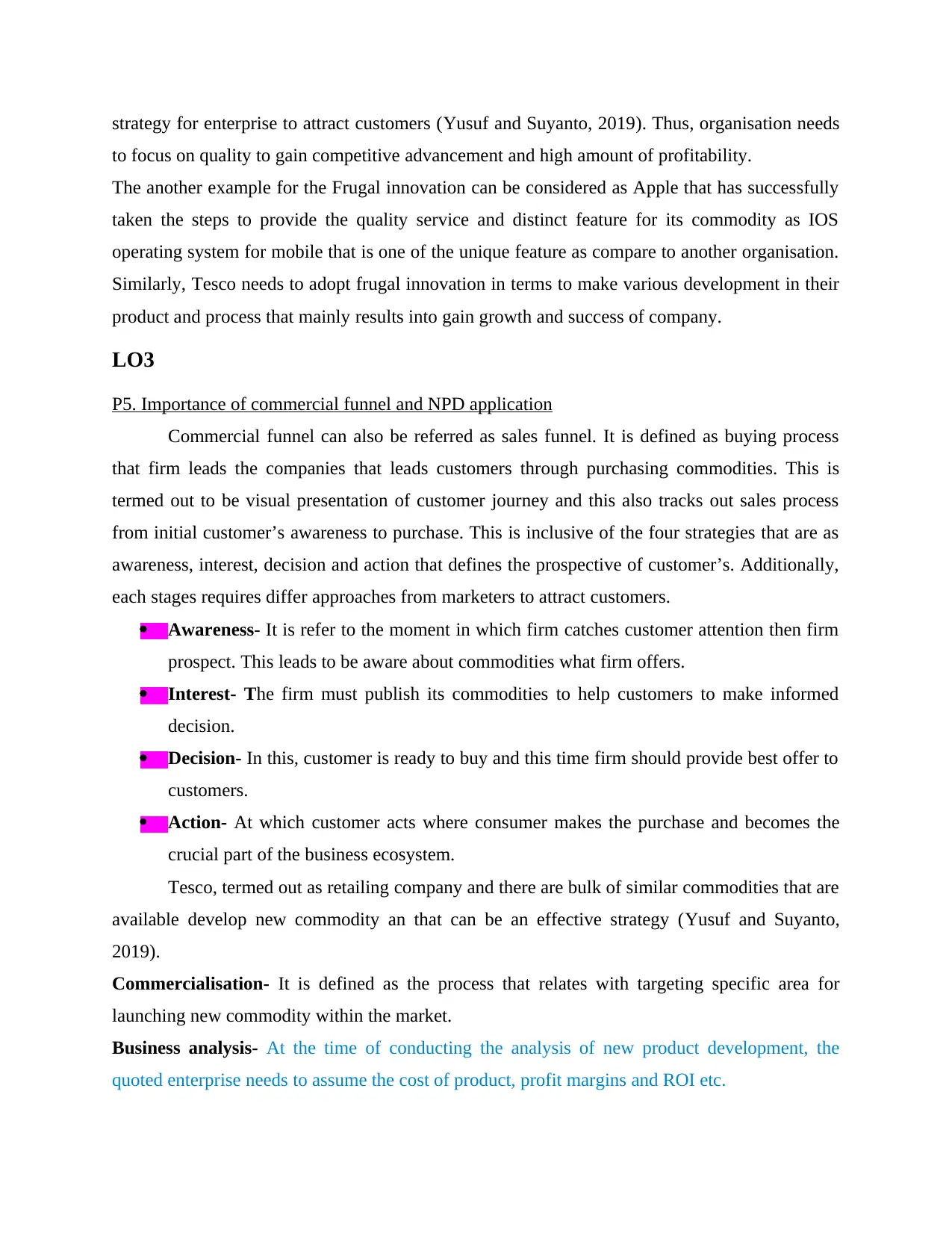
strategy for enterprise to attract customers (Yusuf and Suyanto, 2019). Thus, organisation needs
to focus on quality to gain competitive advancement and high amount of profitability.
The another example for the Frugal innovation can be considered as Apple that has successfully
taken the steps to provide the quality service and distinct feature for its commodity as IOS
operating system for mobile that is one of the unique feature as compare to another organisation.
Similarly, Tesco needs to adopt frugal innovation in terms to make various development in their
product and process that mainly results into gain growth and success of company.
LO3
P5. Importance of commercial funnel and NPD application
Commercial funnel can also be referred as sales funnel. It is defined as buying process
that firm leads the companies that leads customers through purchasing commodities. This is
termed out to be visual presentation of customer journey and this also tracks out sales process
from initial customer’s awareness to purchase. This is inclusive of the four strategies that are as
awareness, interest, decision and action that defines the prospective of customer’s. Additionally,
each stages requires differ approaches from marketers to attract customers.
Awareness- It is refer to the moment in which firm catches customer attention then firm
prospect. This leads to be aware about commodities what firm offers.
Interest- The firm must publish its commodities to help customers to make informed
decision.
Decision- In this, customer is ready to buy and this time firm should provide best offer to
customers.
Action- At which customer acts where consumer makes the purchase and becomes the
crucial part of the business ecosystem.
Tesco, termed out as retailing company and there are bulk of similar commodities that are
available develop new commodity an that can be an effective strategy (Yusuf and Suyanto,
2019).
Commercialisation- It is defined as the process that relates with targeting specific area for
launching new commodity within the market.
Business analysis- At the time of conducting the analysis of new product development, the
quoted enterprise needs to assume the cost of product, profit margins and ROI etc.
to focus on quality to gain competitive advancement and high amount of profitability.
The another example for the Frugal innovation can be considered as Apple that has successfully
taken the steps to provide the quality service and distinct feature for its commodity as IOS
operating system for mobile that is one of the unique feature as compare to another organisation.
Similarly, Tesco needs to adopt frugal innovation in terms to make various development in their
product and process that mainly results into gain growth and success of company.
LO3
P5. Importance of commercial funnel and NPD application
Commercial funnel can also be referred as sales funnel. It is defined as buying process
that firm leads the companies that leads customers through purchasing commodities. This is
termed out to be visual presentation of customer journey and this also tracks out sales process
from initial customer’s awareness to purchase. This is inclusive of the four strategies that are as
awareness, interest, decision and action that defines the prospective of customer’s. Additionally,
each stages requires differ approaches from marketers to attract customers.
Awareness- It is refer to the moment in which firm catches customer attention then firm
prospect. This leads to be aware about commodities what firm offers.
Interest- The firm must publish its commodities to help customers to make informed
decision.
Decision- In this, customer is ready to buy and this time firm should provide best offer to
customers.
Action- At which customer acts where consumer makes the purchase and becomes the
crucial part of the business ecosystem.
Tesco, termed out as retailing company and there are bulk of similar commodities that are
available develop new commodity an that can be an effective strategy (Yusuf and Suyanto,
2019).
Commercialisation- It is defined as the process that relates with targeting specific area for
launching new commodity within the market.
Business analysis- At the time of conducting the analysis of new product development, the
quoted enterprise needs to assume the cost of product, profit margins and ROI etc.
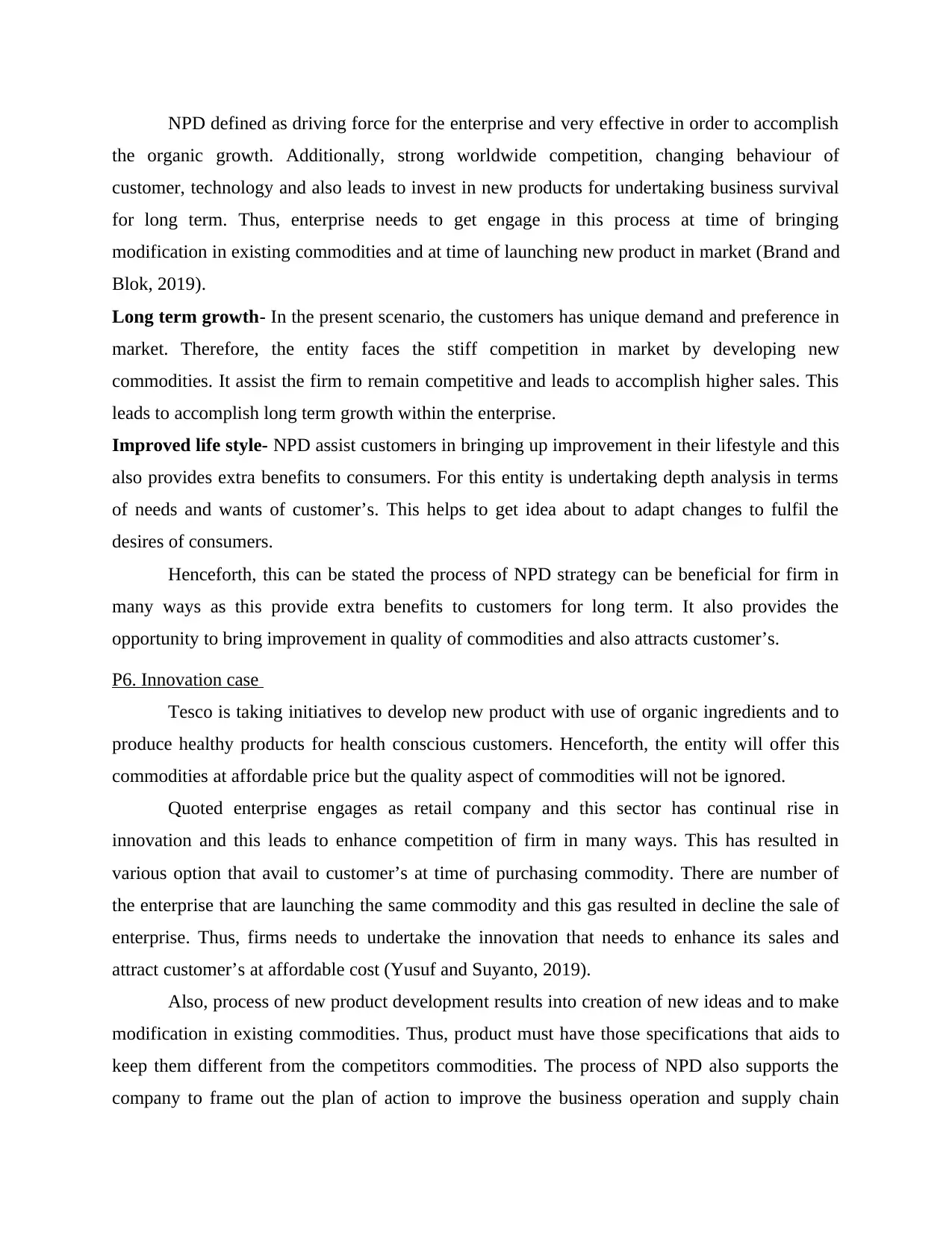
NPD defined as driving force for the enterprise and very effective in order to accomplish
the organic growth. Additionally, strong worldwide competition, changing behaviour of
customer, technology and also leads to invest in new products for undertaking business survival
for long term. Thus, enterprise needs to get engage in this process at time of bringing
modification in existing commodities and at time of launching new product in market (Brand and
Blok, 2019).
Long term growth- In the present scenario, the customers has unique demand and preference in
market. Therefore, the entity faces the stiff competition in market by developing new
commodities. It assist the firm to remain competitive and leads to accomplish higher sales. This
leads to accomplish long term growth within the enterprise.
Improved life style- NPD assist customers in bringing up improvement in their lifestyle and this
also provides extra benefits to consumers. For this entity is undertaking depth analysis in terms
of needs and wants of customer’s. This helps to get idea about to adapt changes to fulfil the
desires of consumers.
Henceforth, this can be stated the process of NPD strategy can be beneficial for firm in
many ways as this provide extra benefits to customers for long term. It also provides the
opportunity to bring improvement in quality of commodities and also attracts customer’s.
P6. Innovation case
Tesco is taking initiatives to develop new product with use of organic ingredients and to
produce healthy products for health conscious customers. Henceforth, the entity will offer this
commodities at affordable price but the quality aspect of commodities will not be ignored.
Quoted enterprise engages as retail company and this sector has continual rise in
innovation and this leads to enhance competition of firm in many ways. This has resulted in
various option that avail to customer’s at time of purchasing commodity. There are number of
the enterprise that are launching the same commodity and this gas resulted in decline the sale of
enterprise. Thus, firms needs to undertake the innovation that needs to enhance its sales and
attract customer’s at affordable cost (Yusuf and Suyanto, 2019).
Also, process of new product development results into creation of new ideas and to make
modification in existing commodities. Thus, product must have those specifications that aids to
keep them different from the competitors commodities. The process of NPD also supports the
company to frame out the plan of action to improve the business operation and supply chain
the organic growth. Additionally, strong worldwide competition, changing behaviour of
customer, technology and also leads to invest in new products for undertaking business survival
for long term. Thus, enterprise needs to get engage in this process at time of bringing
modification in existing commodities and at time of launching new product in market (Brand and
Blok, 2019).
Long term growth- In the present scenario, the customers has unique demand and preference in
market. Therefore, the entity faces the stiff competition in market by developing new
commodities. It assist the firm to remain competitive and leads to accomplish higher sales. This
leads to accomplish long term growth within the enterprise.
Improved life style- NPD assist customers in bringing up improvement in their lifestyle and this
also provides extra benefits to consumers. For this entity is undertaking depth analysis in terms
of needs and wants of customer’s. This helps to get idea about to adapt changes to fulfil the
desires of consumers.
Henceforth, this can be stated the process of NPD strategy can be beneficial for firm in
many ways as this provide extra benefits to customers for long term. It also provides the
opportunity to bring improvement in quality of commodities and also attracts customer’s.
P6. Innovation case
Tesco is taking initiatives to develop new product with use of organic ingredients and to
produce healthy products for health conscious customers. Henceforth, the entity will offer this
commodities at affordable price but the quality aspect of commodities will not be ignored.
Quoted enterprise engages as retail company and this sector has continual rise in
innovation and this leads to enhance competition of firm in many ways. This has resulted in
various option that avail to customer’s at time of purchasing commodity. There are number of
the enterprise that are launching the same commodity and this gas resulted in decline the sale of
enterprise. Thus, firms needs to undertake the innovation that needs to enhance its sales and
attract customer’s at affordable cost (Yusuf and Suyanto, 2019).
Also, process of new product development results into creation of new ideas and to make
modification in existing commodities. Thus, product must have those specifications that aids to
keep them different from the competitors commodities. The process of NPD also supports the
company to frame out the plan of action to improve the business operation and supply chain
Secure Best Marks with AI Grader
Need help grading? Try our AI Grader for instant feedback on your assignments.
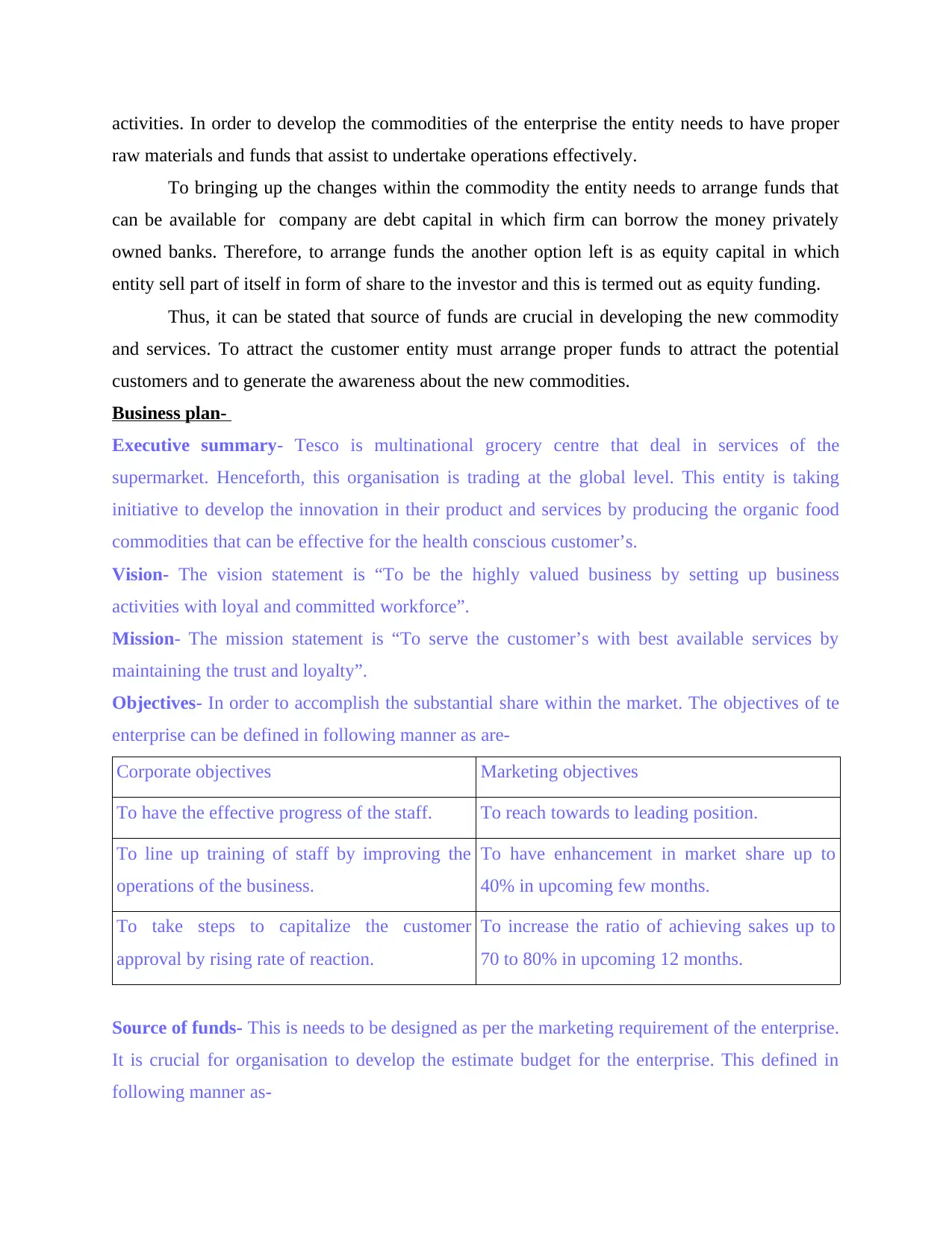
activities. In order to develop the commodities of the enterprise the entity needs to have proper
raw materials and funds that assist to undertake operations effectively.
To bringing up the changes within the commodity the entity needs to arrange funds that
can be available for company are debt capital in which firm can borrow the money privately
owned banks. Therefore, to arrange funds the another option left is as equity capital in which
entity sell part of itself in form of share to the investor and this is termed out as equity funding.
Thus, it can be stated that source of funds are crucial in developing the new commodity
and services. To attract the customer entity must arrange proper funds to attract the potential
customers and to generate the awareness about the new commodities.
Business plan-
Executive summary- Tesco is multinational grocery centre that deal in services of the
supermarket. Henceforth, this organisation is trading at the global level. This entity is taking
initiative to develop the innovation in their product and services by producing the organic food
commodities that can be effective for the health conscious customer’s.
Vision- The vision statement is “To be the highly valued business by setting up business
activities with loyal and committed workforce”.
Mission- The mission statement is “To serve the customer’s with best available services by
maintaining the trust and loyalty”.
Objectives- In order to accomplish the substantial share within the market. The objectives of te
enterprise can be defined in following manner as are-
Corporate objectives Marketing objectives
To have the effective progress of the staff. To reach towards to leading position.
To line up training of staff by improving the
operations of the business.
To have enhancement in market share up to
40% in upcoming few months.
To take steps to capitalize the customer
approval by rising rate of reaction.
To increase the ratio of achieving sakes up to
70 to 80% in upcoming 12 months.
Source of funds- This is needs to be designed as per the marketing requirement of the enterprise.
It is crucial for organisation to develop the estimate budget for the enterprise. This defined in
following manner as-
raw materials and funds that assist to undertake operations effectively.
To bringing up the changes within the commodity the entity needs to arrange funds that
can be available for company are debt capital in which firm can borrow the money privately
owned banks. Therefore, to arrange funds the another option left is as equity capital in which
entity sell part of itself in form of share to the investor and this is termed out as equity funding.
Thus, it can be stated that source of funds are crucial in developing the new commodity
and services. To attract the customer entity must arrange proper funds to attract the potential
customers and to generate the awareness about the new commodities.
Business plan-
Executive summary- Tesco is multinational grocery centre that deal in services of the
supermarket. Henceforth, this organisation is trading at the global level. This entity is taking
initiative to develop the innovation in their product and services by producing the organic food
commodities that can be effective for the health conscious customer’s.
Vision- The vision statement is “To be the highly valued business by setting up business
activities with loyal and committed workforce”.
Mission- The mission statement is “To serve the customer’s with best available services by
maintaining the trust and loyalty”.
Objectives- In order to accomplish the substantial share within the market. The objectives of te
enterprise can be defined in following manner as are-
Corporate objectives Marketing objectives
To have the effective progress of the staff. To reach towards to leading position.
To line up training of staff by improving the
operations of the business.
To have enhancement in market share up to
40% in upcoming few months.
To take steps to capitalize the customer
approval by rising rate of reaction.
To increase the ratio of achieving sakes up to
70 to 80% in upcoming 12 months.
Source of funds- This is needs to be designed as per the marketing requirement of the enterprise.
It is crucial for organisation to develop the estimate budget for the enterprise. This defined in
following manner as-
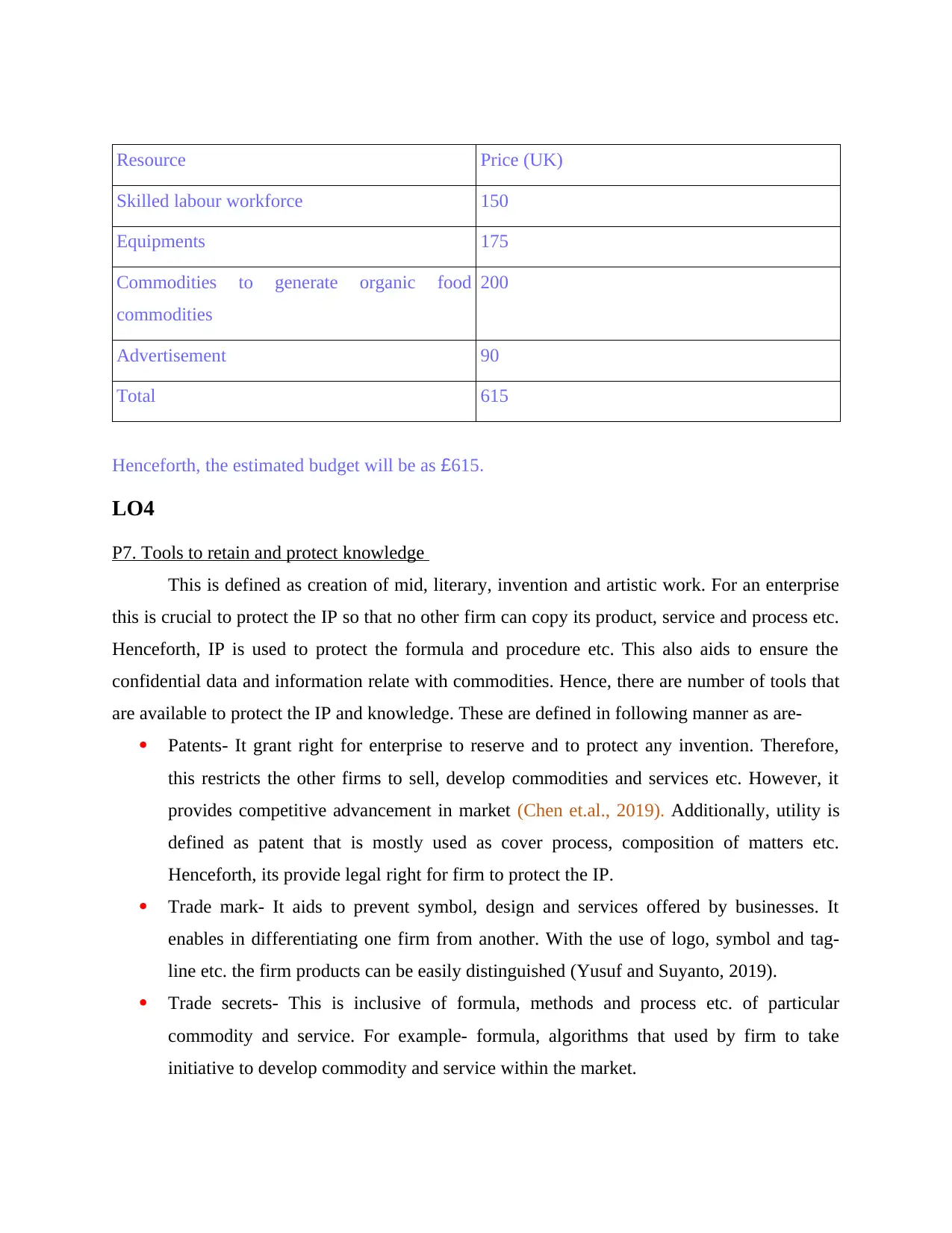
Resource Price (UK)
Skilled labour workforce 150
Equipments 175
Commodities to generate organic food
commodities
200
Advertisement 90
Total 615
Henceforth, the estimated budget will be as £615.
LO4
P7. Tools to retain and protect knowledge
This is defined as creation of mid, literary, invention and artistic work. For an enterprise
this is crucial to protect the IP so that no other firm can copy its product, service and process etc.
Henceforth, IP is used to protect the formula and procedure etc. This also aids to ensure the
confidential data and information relate with commodities. Hence, there are number of tools that
are available to protect the IP and knowledge. These are defined in following manner as are-
Patents- It grant right for enterprise to reserve and to protect any invention. Therefore,
this restricts the other firms to sell, develop commodities and services etc. However, it
provides competitive advancement in market (Chen et.al., 2019). Additionally, utility is
defined as patent that is mostly used as cover process, composition of matters etc.
Henceforth, its provide legal right for firm to protect the IP.
Trade mark- It aids to prevent symbol, design and services offered by businesses. It
enables in differentiating one firm from another. With the use of logo, symbol and tag-
line etc. the firm products can be easily distinguished (Yusuf and Suyanto, 2019).
Trade secrets- This is inclusive of formula, methods and process etc. of particular
commodity and service. For example- formula, algorithms that used by firm to take
initiative to develop commodity and service within the market.
Skilled labour workforce 150
Equipments 175
Commodities to generate organic food
commodities
200
Advertisement 90
Total 615
Henceforth, the estimated budget will be as £615.
LO4
P7. Tools to retain and protect knowledge
This is defined as creation of mid, literary, invention and artistic work. For an enterprise
this is crucial to protect the IP so that no other firm can copy its product, service and process etc.
Henceforth, IP is used to protect the formula and procedure etc. This also aids to ensure the
confidential data and information relate with commodities. Hence, there are number of tools that
are available to protect the IP and knowledge. These are defined in following manner as are-
Patents- It grant right for enterprise to reserve and to protect any invention. Therefore,
this restricts the other firms to sell, develop commodities and services etc. However, it
provides competitive advancement in market (Chen et.al., 2019). Additionally, utility is
defined as patent that is mostly used as cover process, composition of matters etc.
Henceforth, its provide legal right for firm to protect the IP.
Trade mark- It aids to prevent symbol, design and services offered by businesses. It
enables in differentiating one firm from another. With the use of logo, symbol and tag-
line etc. the firm products can be easily distinguished (Yusuf and Suyanto, 2019).
Trade secrets- This is inclusive of formula, methods and process etc. of particular
commodity and service. For example- formula, algorithms that used by firm to take
initiative to develop commodity and service within the market.
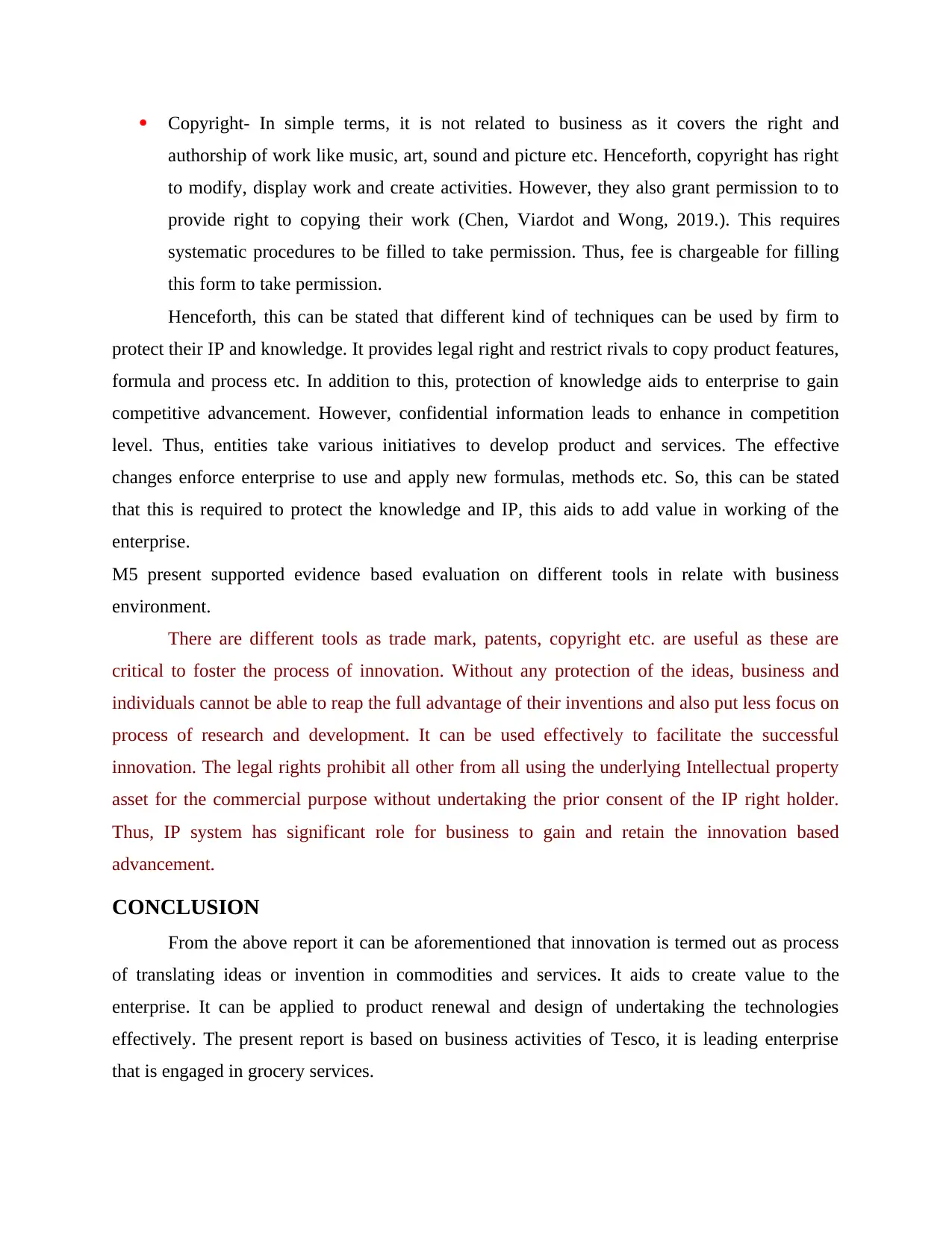
Copyright- In simple terms, it is not related to business as it covers the right and
authorship of work like music, art, sound and picture etc. Henceforth, copyright has right
to modify, display work and create activities. However, they also grant permission to to
provide right to copying their work (Chen, Viardot and Wong, 2019.). This requires
systematic procedures to be filled to take permission. Thus, fee is chargeable for filling
this form to take permission.
Henceforth, this can be stated that different kind of techniques can be used by firm to
protect their IP and knowledge. It provides legal right and restrict rivals to copy product features,
formula and process etc. In addition to this, protection of knowledge aids to enterprise to gain
competitive advancement. However, confidential information leads to enhance in competition
level. Thus, entities take various initiatives to develop product and services. The effective
changes enforce enterprise to use and apply new formulas, methods etc. So, this can be stated
that this is required to protect the knowledge and IP, this aids to add value in working of the
enterprise.
M5 present supported evidence based evaluation on different tools in relate with business
environment.
There are different tools as trade mark, patents, copyright etc. are useful as these are
critical to foster the process of innovation. Without any protection of the ideas, business and
individuals cannot be able to reap the full advantage of their inventions and also put less focus on
process of research and development. It can be used effectively to facilitate the successful
innovation. The legal rights prohibit all other from all using the underlying Intellectual property
asset for the commercial purpose without undertaking the prior consent of the IP right holder.
Thus, IP system has significant role for business to gain and retain the innovation based
advancement.
CONCLUSION
From the above report it can be aforementioned that innovation is termed out as process
of translating ideas or invention in commodities and services. It aids to create value to the
enterprise. It can be applied to product renewal and design of undertaking the technologies
effectively. The present report is based on business activities of Tesco, it is leading enterprise
that is engaged in grocery services.
authorship of work like music, art, sound and picture etc. Henceforth, copyright has right
to modify, display work and create activities. However, they also grant permission to to
provide right to copying their work (Chen, Viardot and Wong, 2019.). This requires
systematic procedures to be filled to take permission. Thus, fee is chargeable for filling
this form to take permission.
Henceforth, this can be stated that different kind of techniques can be used by firm to
protect their IP and knowledge. It provides legal right and restrict rivals to copy product features,
formula and process etc. In addition to this, protection of knowledge aids to enterprise to gain
competitive advancement. However, confidential information leads to enhance in competition
level. Thus, entities take various initiatives to develop product and services. The effective
changes enforce enterprise to use and apply new formulas, methods etc. So, this can be stated
that this is required to protect the knowledge and IP, this aids to add value in working of the
enterprise.
M5 present supported evidence based evaluation on different tools in relate with business
environment.
There are different tools as trade mark, patents, copyright etc. are useful as these are
critical to foster the process of innovation. Without any protection of the ideas, business and
individuals cannot be able to reap the full advantage of their inventions and also put less focus on
process of research and development. It can be used effectively to facilitate the successful
innovation. The legal rights prohibit all other from all using the underlying Intellectual property
asset for the commercial purpose without undertaking the prior consent of the IP right holder.
Thus, IP system has significant role for business to gain and retain the innovation based
advancement.
CONCLUSION
From the above report it can be aforementioned that innovation is termed out as process
of translating ideas or invention in commodities and services. It aids to create value to the
enterprise. It can be applied to product renewal and design of undertaking the technologies
effectively. The present report is based on business activities of Tesco, it is leading enterprise
that is engaged in grocery services.
Paraphrase This Document
Need a fresh take? Get an instant paraphrase of this document with our AI Paraphraser
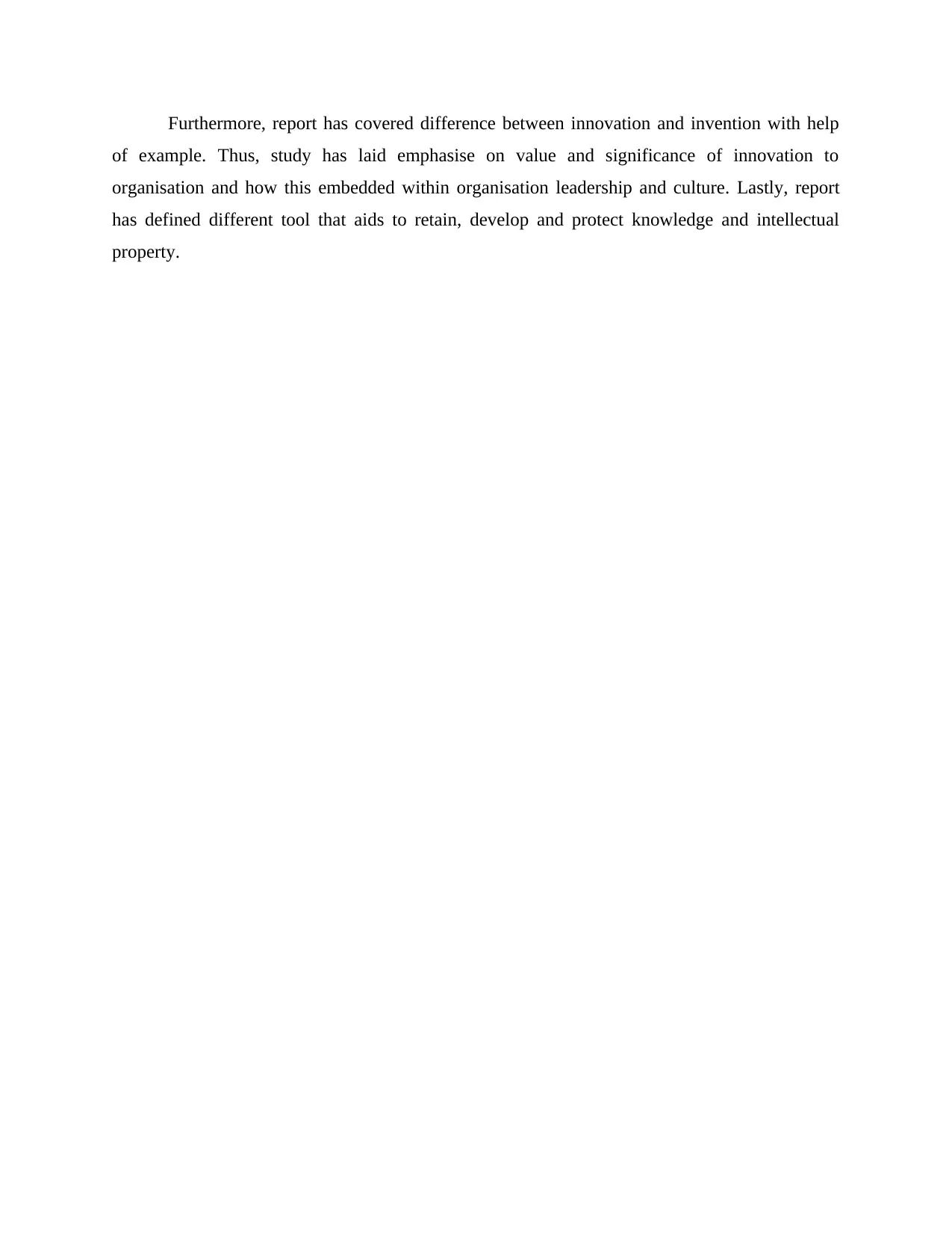
Furthermore, report has covered difference between innovation and invention with help
of example. Thus, study has laid emphasise on value and significance of innovation to
organisation and how this embedded within organisation leadership and culture. Lastly, report
has defined different tool that aids to retain, develop and protect knowledge and intellectual
property.
of example. Thus, study has laid emphasise on value and significance of innovation to
organisation and how this embedded within organisation leadership and culture. Lastly, report
has defined different tool that aids to retain, develop and protect knowledge and intellectual
property.
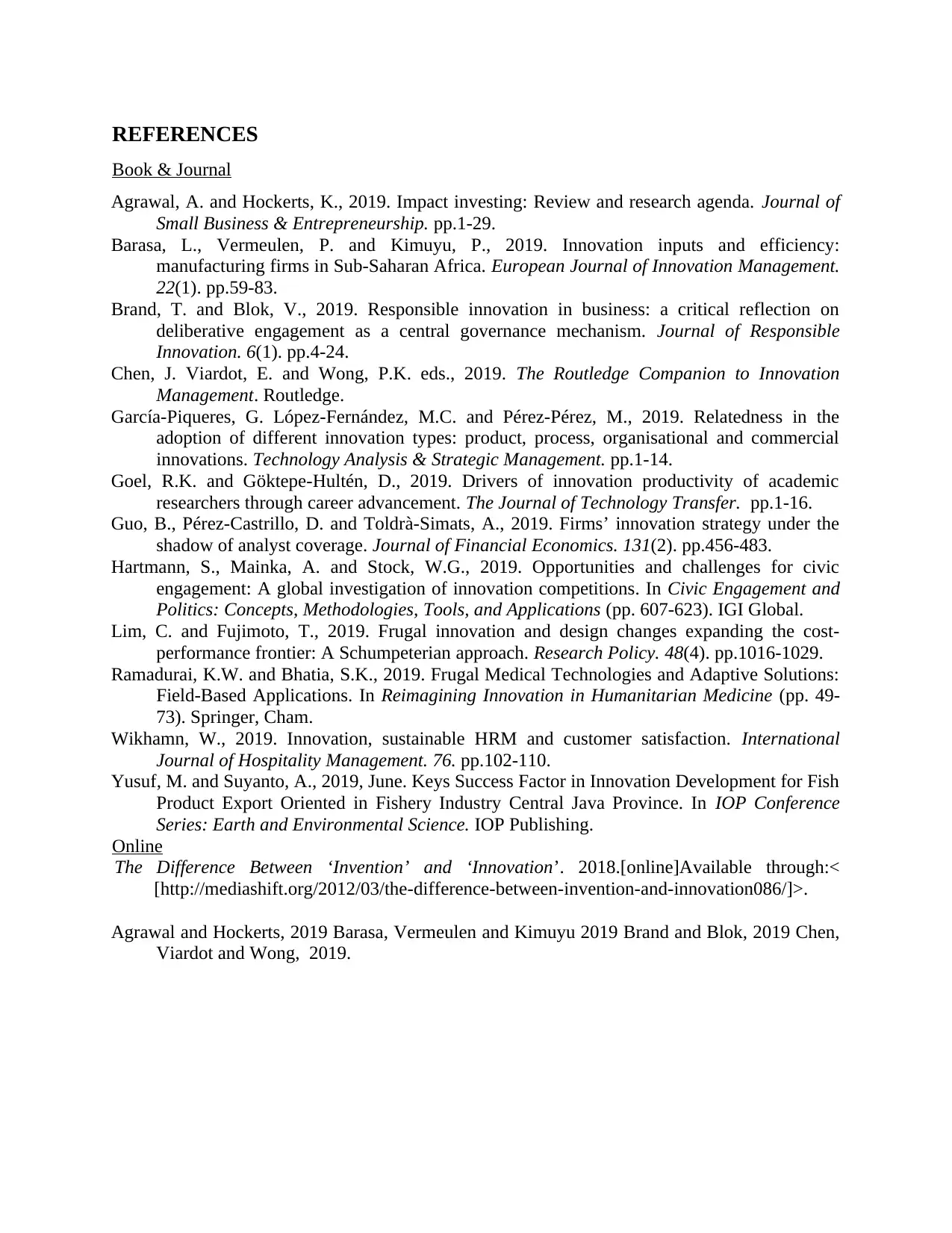
REFERENCES
Book & Journal
Agrawal, A. and Hockerts, K., 2019. Impact investing: Review and research agenda. Journal of
Small Business & Entrepreneurship. pp.1-29.
Barasa, L., Vermeulen, P. and Kimuyu, P., 2019. Innovation inputs and efficiency:
manufacturing firms in Sub-Saharan Africa. European Journal of Innovation Management.
22(1). pp.59-83.
Brand, T. and Blok, V., 2019. Responsible innovation in business: a critical reflection on
deliberative engagement as a central governance mechanism. Journal of Responsible
Innovation. 6(1). pp.4-24.
Chen, J. Viardot, E. and Wong, P.K. eds., 2019. The Routledge Companion to Innovation
Management. Routledge.
García-Piqueres, G. López-Fernández, M.C. and Pérez-Pérez, M., 2019. Relatedness in the
adoption of different innovation types: product, process, organisational and commercial
innovations. Technology Analysis & Strategic Management. pp.1-14.
Goel, R.K. and Göktepe-Hultén, D., 2019. Drivers of innovation productivity of academic
researchers through career advancement. The Journal of Technology Transfer. pp.1-16.
Guo, B., Pérez-Castrillo, D. and Toldrà-Simats, A., 2019. Firms’ innovation strategy under the
shadow of analyst coverage. Journal of Financial Economics. 131(2). pp.456-483.
Hartmann, S., Mainka, A. and Stock, W.G., 2019. Opportunities and challenges for civic
engagement: A global investigation of innovation competitions. In Civic Engagement and
Politics: Concepts, Methodologies, Tools, and Applications (pp. 607-623). IGI Global.
Lim, C. and Fujimoto, T., 2019. Frugal innovation and design changes expanding the cost-
performance frontier: A Schumpeterian approach. Research Policy. 48(4). pp.1016-1029.
Ramadurai, K.W. and Bhatia, S.K., 2019. Frugal Medical Technologies and Adaptive Solutions:
Field-Based Applications. In Reimagining Innovation in Humanitarian Medicine (pp. 49-
73). Springer, Cham.
Wikhamn, W., 2019. Innovation, sustainable HRM and customer satisfaction. International
Journal of Hospitality Management. 76. pp.102-110.
Yusuf, M. and Suyanto, A., 2019, June. Keys Success Factor in Innovation Development for Fish
Product Export Oriented in Fishery Industry Central Java Province. In IOP Conference
Series: Earth and Environmental Science. IOP Publishing.
Online
The Difference Between ‘Invention’ and ‘Innovation’. 2018.[online]Available through:<
[http://mediashift.org/2012/03/the-difference-between-invention-and-innovation086/]>.
Agrawal and Hockerts, 2019 Barasa, Vermeulen and Kimuyu 2019 Brand and Blok, 2019 Chen,
Viardot and Wong, 2019.
Book & Journal
Agrawal, A. and Hockerts, K., 2019. Impact investing: Review and research agenda. Journal of
Small Business & Entrepreneurship. pp.1-29.
Barasa, L., Vermeulen, P. and Kimuyu, P., 2019. Innovation inputs and efficiency:
manufacturing firms in Sub-Saharan Africa. European Journal of Innovation Management.
22(1). pp.59-83.
Brand, T. and Blok, V., 2019. Responsible innovation in business: a critical reflection on
deliberative engagement as a central governance mechanism. Journal of Responsible
Innovation. 6(1). pp.4-24.
Chen, J. Viardot, E. and Wong, P.K. eds., 2019. The Routledge Companion to Innovation
Management. Routledge.
García-Piqueres, G. López-Fernández, M.C. and Pérez-Pérez, M., 2019. Relatedness in the
adoption of different innovation types: product, process, organisational and commercial
innovations. Technology Analysis & Strategic Management. pp.1-14.
Goel, R.K. and Göktepe-Hultén, D., 2019. Drivers of innovation productivity of academic
researchers through career advancement. The Journal of Technology Transfer. pp.1-16.
Guo, B., Pérez-Castrillo, D. and Toldrà-Simats, A., 2019. Firms’ innovation strategy under the
shadow of analyst coverage. Journal of Financial Economics. 131(2). pp.456-483.
Hartmann, S., Mainka, A. and Stock, W.G., 2019. Opportunities and challenges for civic
engagement: A global investigation of innovation competitions. In Civic Engagement and
Politics: Concepts, Methodologies, Tools, and Applications (pp. 607-623). IGI Global.
Lim, C. and Fujimoto, T., 2019. Frugal innovation and design changes expanding the cost-
performance frontier: A Schumpeterian approach. Research Policy. 48(4). pp.1016-1029.
Ramadurai, K.W. and Bhatia, S.K., 2019. Frugal Medical Technologies and Adaptive Solutions:
Field-Based Applications. In Reimagining Innovation in Humanitarian Medicine (pp. 49-
73). Springer, Cham.
Wikhamn, W., 2019. Innovation, sustainable HRM and customer satisfaction. International
Journal of Hospitality Management. 76. pp.102-110.
Yusuf, M. and Suyanto, A., 2019, June. Keys Success Factor in Innovation Development for Fish
Product Export Oriented in Fishery Industry Central Java Province. In IOP Conference
Series: Earth and Environmental Science. IOP Publishing.
Online
The Difference Between ‘Invention’ and ‘Innovation’. 2018.[online]Available through:<
[http://mediashift.org/2012/03/the-difference-between-invention-and-innovation086/]>.
Agrawal and Hockerts, 2019 Barasa, Vermeulen and Kimuyu 2019 Brand and Blok, 2019 Chen,
Viardot and Wong, 2019.
1 out of 15
Related Documents
Your All-in-One AI-Powered Toolkit for Academic Success.
+13062052269
info@desklib.com
Available 24*7 on WhatsApp / Email
![[object Object]](/_next/static/media/star-bottom.7253800d.svg)
Unlock your academic potential
© 2024 | Zucol Services PVT LTD | All rights reserved.




